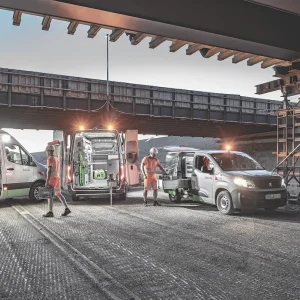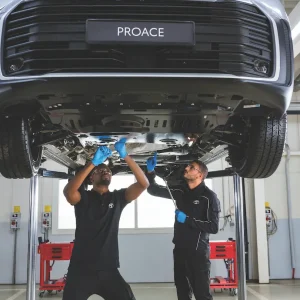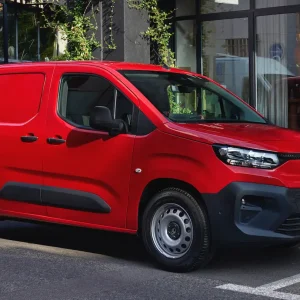The van comes with 100, 125 and 155hp versions of the 2.2-litre diesel engine and a choice of two wheelbases, both of which, claims Ford, offer class-leading load volume, although others in the sector manage more thanks to high-roof options. But with Ford aiming to promote the Transit as a van that users are happy to have parked outside their house, and one that can get into low-barriered car parks, a high-roof alternative won’t be offered, at least early on. The short-wheelbase model can also take three euro pallets with a one-metre high load, claims Ford, which it says is unique in the sector and something the previous Transit couldn’t handle. 
The interior is a particular revelation, and borrows switchgear and materials from the passenger car range like never before. It’s an over-used phrase, but it is the most car-like interior this side of actual car-derived vans, and leads the market for quality. The welcome and very long-overdue reach-adjustment for the steering wheel helps increase comfort, as do the extra setting options for the driver’s seat. 
There’s also much more in the way of car-like features being offered by the new Transit Custom. Ford’s optional Sync voice-activated system enables mobile phones and music players to be connected to the system and operated by voice commands, while the system also combines with the Emergency Assistance function that provides location information to the emergency services in the event of an incident. Lane-keeping alert, driver fatigue detector and reversing camera are also available for various additional costs.
But the innovation doesn't begin and end in the cabin, and Ford has certainly not rested on its laurels with the new van. A series of developments designed off the back of customer feedback to help make life easier for operators have been engineered in. Some of these are particularly groundbreaking, and can be expected to spread across the industry as rivals get a look at what Ford has done and likely devise their own versions.
One such feature, available as an option expected to cost around £350, is the integrated roof rack that drops seamlessly into the van's roof when not in use. Three transverse bars are located in the recesses of the roof, saving the hassle of fitting and removing a rack, or saving businesses money through the greater fuel efficiency and reduced drag of not having an unused roof rack fitted to
the vehicle.
The load-through facility in the Custom's bulkhead is a clever yet seemingly simple answer to these medium-sized vans occasionally being required to carry longer loads, such as piping or ladders. A hinged panel at the foot of the bulkhead opens up, extending the van's load length by almost half a metre to 3.0m in the SWB or 3.4m in the LWB by running into a loadspace under the dual passenger seat. 
The loadspace itself has also been carefully considered, with the tie-down hooks and fixing points moved to the body side in order to leave the floor clear of intrusion or recess to help with both usability and cleaning. The cargo area itself will be available with what Ford calls an easy-clean load liner similar to a pick-up truck load bed, sealed and running up to 80mm up the side of the load area, protecting the steel base from loading damage. LED lighting is also being offered for the first time in the load area, with four high-output lights illuminating the rear for users employing the back of the van as workspace. That will also be aided by the ability to lock the door arms in place at 90° to prevent the wind blowing them shut.
There is, though, more to the Transit Custom than clever innovation. It has also managed to maintain its strengths, particularly in the areas of looks and driving enjoyment. Very little can touch Ford light commercial vehicles for driver pleasure, which, while not important to larger fleets, is a consideration for owner-drivers and for anyone spending large amounts of time behind the wheel. Steering, gearchange, ride and handling are all up with the best in the business, and that added steering wheel and driver's seat adjustment helps increase driver comfort.
The Transit Custom is one of the most stylish medium vans an owner-driver could have parked outside their house. While still a panel van and therefore not the most subtle of machines, the rounded, friendly nose is significantly less harsh than some rivals' and makes it one of the more attractive on the market.
The only major weakness for the new Transit Custom is a payload that's significantly below virtually all its competitors. If carrying heavy loads is crucial to a business, then this probably isn't the light commercial of choice, but if that's not a worry then the Custom is an excellent, clever, well-engineered and appealing new entrant that has every chance of extending Ford's light commercial vehicle dominance to the end of the decade and beyond. It's a very worthy choice for What Van?'s Van of the Year.





